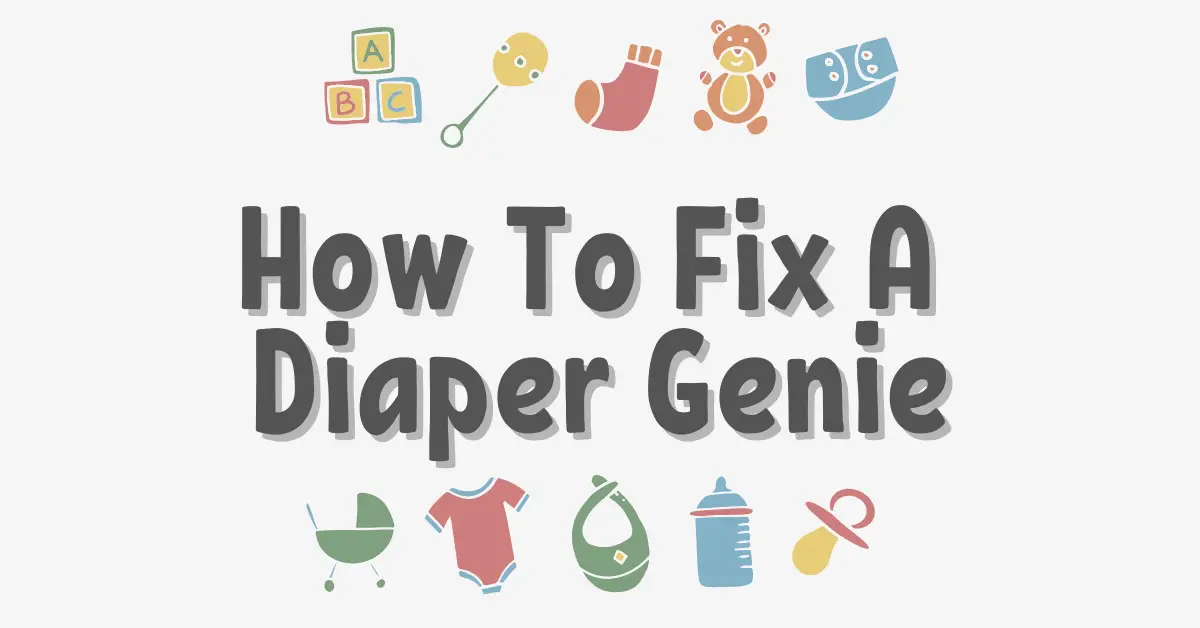A diaper genie is a baby necessity that often goes unappreciated until a malfunction occurs. It’s one of those inventions that seamlessly integrates into our daily routine, providing an invaluable service: odor-free diaper disposal. It simplifies an aspect of parenting babies, offering a clean, efficient way to dispose of diapers without constantly running to the outside bin.
Despite its seemingly simple operation, the Diaper Genie is a complex mechanism that can sometimes run into problems. Some parents might face issues with the clamping mechanism, struggle with refilling the bags, or deal with less than perfect odor containment. All these can disrupt the otherwise smooth running of your household, creating unnecessary stress in an already busy day.
That’s why knowing how to fix a Diaper Genie is a practical skill all parents should consider learning. It not only saves money that might otherwise be spent on professional repair or replacement but also minimizes the downtime of this essential device. This article is designed to help you understand the anatomy of your Diaper Genie, identify common problems, and guide you through fixing them. Let’s get started!
Understanding the Components of a Diaper Genie
Before diving into the fixes, it’s helpful to understand the basic components of a Diaper Genie and their respective functions. The Diaper Genie is an ingenious combination of parts working in sync to make diaper disposal efficient, hygienic, and odor-free. The components and their roles are as follows:
- Top Lid: This is where you place the soiled diaper. Once the lid is closed, the diaper falls into the bag system below.
- Push-N-Lock Clamp: This is an integral part of the mechanism. When you close the lid, this clamp is designed to push the diaper down into the bag and lock in the odor.
- Diaper Insertion Compartment: This is the space where the diaper resides after being pushed through the clamp, and before it falls into the bag.
- Refill Bag System: This is a continuous bagging system where the diapers are stored. It is designed to be cut and tied off when full, allowing you to dispose of a bag of diapers while still having bag length left for future diapers.
- Odor Control Mechanism: The design of the lid, clamp, and bag system all work together to ensure that the odors from soiled diapers are contained within the unit.
Each component plays a crucial role in the overall function of the Diaper Genie, and issues can arise when any one of them is not working properly. Familiarity with these components will help you to better diagnose any problems that occur, and make fixing those issues easier.

Identifying Common Problems with a Diaper Genie
Once you’ve familiarized yourself with the basic components of a Diaper Genie, the next step is to identify common problems you might face. Issues can arise from normal wear and tear, misuse, or a fault in the product itself. Here, we highlight the most frequently reported problems and give quick diagnosis methods for each.
- Difficulties with the Push-N-Lock Clamp: One of the most common issues is with the clamp that pushes the diaper down into the bag. You may find that it’s not pushing down or coming back up as it should. In most cases, this issue arises when the clamp becomes stuck due to a diaper getting lodged in an awkward position.
- Problems with the Refill Bags: Another common problem revolves around the refill bags. This might manifest in difficulties removing a full bag, problems inserting a new one, or the bag not catching the diapers properly, leading them to fall outside the intended storage area. Incorrect installation is often the culprit behind these issues.
- Issues with the Smell Containment: If you notice a persistent smell despite having recently emptied the Diaper Genie, it could indicate a problem with the smell containment system. This could be due to a failure in the Push-N-Lock clamp or an improperly sealed bag.
When diagnosing your Diaper Genie, start by identifying which of the primary functions – clamping, bagging, or odor containment – is not working correctly. Then, refer to the component breakdown in Section II to associate this function with its corresponding parts. This will help you determine where to focus when it comes to troubleshooting and fixing the problem.

Fixing Broken Diaper Genies: Step-by-Step Guides
In this section, we delve into the solutions for the common issues identified earlier. Each subsection will provide a step-by-step guide on how to fix the problem, ensuring your Diaper Genie returns to optimal functioning as quickly as possible.
A. How to Fix Issues with the Push-N-Lock Clamp
- Carefully open the Diaper Genie and visually inspect the clamp for any obvious obstructions, like a stuck diaper.
- If an obstruction is present, carefully remove it using a pair of tongs or tweezers. Avoid using your hands to prevent potential contact with soiled diapers.
- Once the obstruction is removed, test the clamp by manually moving it up and down. It should move smoothly. If it’s still sticking, consider using a baby-safe lubricant on the hinge points.
- Reassemble the Diaper Genie and check if it’s functioning properly.
B. How to Fix Problems with the Refill Bags
- If you’re having trouble removing a full bag, check to ensure that it’s not overfilled. If it is, you may need to gently push down on the contents to make removal easier.
- When inserting a new refill bag, follow the instructions on the refill package closely. Make sure that the end of the bag is pulled through the bottom and tied off securely to prevent diapers from falling out of place.
- If the bag isn’t catching diapers properly, double-check that it’s installed correctly and tied off at the bottom. You may need to remove and reinsert the bag.
C. How to Address Issues with Smell Containment
- If you notice persistent odors, first check to ensure that the bag is properly sealed and that the clamp is functioning as it should.
- Deep clean the Diaper Genie. Often, residual odors can stick to the interior over time. Use a gentle, baby-safe disinfectant and scrub the interior, paying particular attention to the lid and the clamp area.
- Ensure that the Diaper Genie is closed properly after each use. Even a small gap can let odors escape.
- Consider adding a deodorizer designed for Diaper Genies. These often come in the form of a puck that can be inserted into the lid or a powder that can be sprinkled into the bag.
Remember, while these steps can help you fix the common issues, it’s always important to refer to your Diaper Genie’s manual for any manufacturer-specific guidelines.
Preventive Measures to Avoid Future Problems with Diaper Genie
To maintain a smoothly functioning Diaper Genie, prevention is often the best approach. Regular cleaning, proper usage, and occasional maintenance can keep your unit in top shape and extend its lifespan.
A. Routine Cleaning and Maintenance Tips
- Regularly clean your Diaper Genie with a mild, baby-safe detergent. This helps prevent odors from building up over time and keeps the various components working smoothly.
- Inspect the Push-N-Lock clamp regularly for any signs of wear and tear, and lubricate if necessary with a baby-safe product. This can prevent it from getting stuck or not working as it should.
- Empty the Diaper Genie when it’s about three-quarters full. Overfilling can lead to issues with both the clamp and the bag system.
B. Proper Usage Guidelines to Prolong the Lifespan of the Diaper Genie
- Ensure you’re using the correct Diaper Genie refills. While other bags may fit, they may not work as effectively in controlling odors or could lead to other operational issues.
- Be gentle when operating the Diaper Genie, especially when pushing the diaper through the clamp and when removing a full bag.
- Make sure that the lid is closed properly after each use. Leaving it open can allow odors to escape and may cause the clamp to malfunction.
C. When and Where to Seek Professional Help or Consider a Replacement
- If the same issue keeps recurring despite following the troubleshooting steps, it might be time to contact the manufacturer’s customer service for assistance.
- If your Diaper Genie is several years old and experiencing frequent problems, it could be more cost-effective to replace it rather than continually fixing it.
- Remember that while the Diaper Genie is designed to be durable, like any item with moving parts, it won’t last forever. Regular replacement of key components, such as the clamp, might be necessary over the lifespan of the unit.
By following these preventive measures and guidelines, you can ensure your Diaper Genie continues to function effectively, making your life as a parent a little easier and a bit more odor-free!
Final Thoughts On How To Fix A Diaper Genie
The Diaper Genie, while a simple household tool, plays an important role in managing baby care tasks, specifically in hygienic and odor-free diaper disposal. Understanding its components and functioning, recognizing common problems, and being equipped with the knowledge to fix these issues are essential skills for any parent or caregiver.
We’ve traversed the landscape of Diaper Genie troubleshooting, covering everything from its basic components to problem identification and resolution. We’ve also outlined preventive measures to help avoid future issues and keep your Diaper Genie in optimal working condition.
Remember, proactive care and routine maintenance of your Diaper Genie can ensure its longevity and effectiveness. Don’t wait for a problem to arise before you familiarize yourself with this invaluable tool. Embrace the challenge of troubleshooting and fixing minor issues, but also recognize when it’s time to seek professional help or consider a replacement.
Through this guide, we hope to have equipped you with the necessary knowledge to tackle Diaper Genie issues with confidence and ease, ensuring a smooth, efficient, and odorless diaper disposal process for your home.

